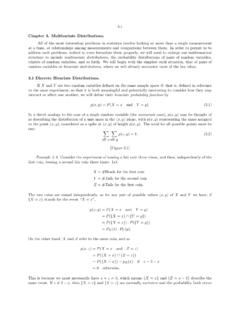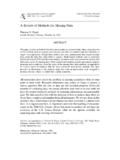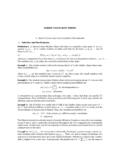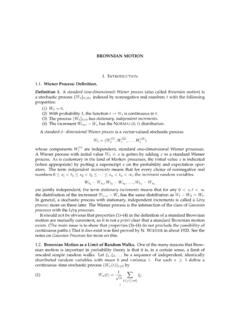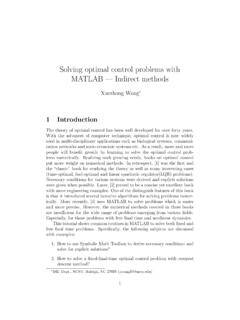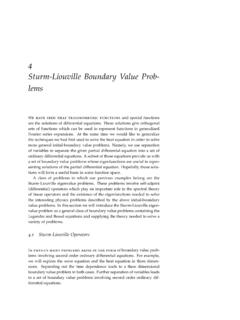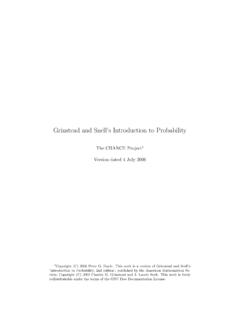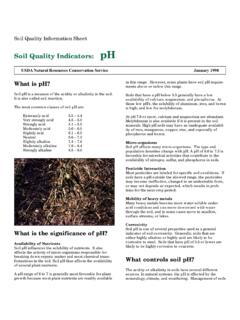Transcription of ONE-DIMENSIONAL RANDOM WALKS - University of Chicago
1 ONE-DIMENSIONAL RANDOM WALKS1. SIM P LERA NDO MWA LKDefinition walkon the integersZwith step distributionFand initial statex Zis a sequenceSnof RANDOM variables whose increments are independent, identically distributedrandom variables iwith common distributionF, that is,(1)Sn=x+n i=1 definition extends in an obvious way to RANDOM WALKS on thed dimensional integer lat-ticeZd: the increments are then randomd RANDOM walkonZdis the particularcase where the step distribution is the uniform distribution on the 2dnearest neighbors of theorigin; in one dimension, this is theRademacher-12distribution, the distribution that puts mass1/2 at each of the two values 1.
2 The moves of a simple RANDOM walk in 1D are determined byindependent fair coin tosses: For each Head, jump one to the right; for each Tail, jump one tothe s RANDOM walk describes (among other things) the fluctuations in aspeculator s wealth when he/she is fully invested in a risky asset whose value jumps by either 1 in each time period. Although this seems far too simple a model to be of any practical value,when the unit of time is small ( , seconds) it isn t so bad, at least over periods on the order ofdays or weeks, and in fact it is commonly used as the basis of the so-calledtree modelsfor s Ruin Problem:Suppose I start withxdollars.
3 What is the probability that my fortunewill grow toAdollars before I go broke? More precisely, if(2)T=T[0,A]:=min{n:Sn=0 orA}then what isPx{ST=A}?1 Before we try to answer this, we need to verify thatT< with prob -ability 1. To see that this is so, observe that if at any time during the course of the game there isa run ofAconsecutive Heads, then the game must end, because my fortune will have increasedby at leastAdollars. But if I toss a fair coin forever, a run ofAconsecutive Heads will certainlyoccur. (Why?)Difference Equations:To solve the gambler s ruin problem, we ll set up and solve adifferenceequationfor the quantity of interest(3)u(x):=Px{ST=A}.
4 First, if I start withAdollars then I have already reached my goal, sou(A)=1; similarly,u(0)= consider what happens on the very first play, if 0<x<A: either I toss a Head, in which case1 Here and throughout the course, the superscriptxdenotes the initial state of the processSn. When there is nosuperscript, the initial state isx=0. Thus,P= RANDOM WALKSmy fortune increases by 1, or I toss a tail, in which case it decreases by 1. At this point, it is likestarting the game from scratch, but with initial fortune eitherx+1 orx 1. Hence,usatisfiesthe difference equation(4)u(x)=12u(x+1)+12u(x 1) 1 x A 1and the boundary conditionsu(A)=1;(5)u(0)= do we solve this?
5 The most direct approach is to translate the difference equation into arelation between the successive differencesu(x+1) u(x)andu(x) u(x 1):(6)12(u(x+1) u(x))=12(u(x) u(x 1)).This equation says that the successive differences in the functionuare all the same, and it is easyto see (exercise!) that the only functions with this property arelinearfunctionsu(x)=B x+ , any linear function solves (4). To determine the coefficientsB,C, use the boundaryconditions: these implyC=0 andB=1/A. This provesProposition {ST=A}=x/A . will see later in the course that first-passage problems for Markov chains andcontinuous-time Markov processes are, in much the same way, related to boundary value prob - lems for other difference and differential operators.
6 This is the basis for what has become knownasprobabilistic potential theory. The connection is also of practical importance, because it leadsto the possibility ofsimulatingthe solutions to boundary value problems by running randomwalks and Markov chains on solving the difference equation (4) , we used it to obtain a relation (6) between suc-cessive differences of the unknown functionu. This doesn t always work. However, in general, ifa difference equation is of orderm, then it relatesu(x)to the lastmvaluesu(x 1), .. ,u(x m).Thus, it relates thevectorU(x):=(u(x),u(x 1), .. ,u(x m+1))to the vectorU(x 1):=(u(x 1),u(x 2).)
7 ,u(x m)).If the difference equation islinear, as is usually the case in Markov chain problems, then thisrelation can be formulated as a matrix equationM U(x 1)=U(x). This can then be solved bymatrix multiplication. Following is a simple example where this point of view is Duration of the Game:Now that we know the probabilities of winning and losing, itwould be nice to know how long the game will take. This isn t a well-posed problem, because thedurationTof the game is RANDOM , but we can at least calculateExT. Once again, we will usedifference equations: Set(7)v(x):=ExT;thenv(0)=v(A)=0 and, by reasoning similar to that used above,(8)v(x)=1+12v(x 1)+12v(x+1) 1 x A RANDOM WALKS3 The new feature is the additional term 1 on the right this makes the solve this, we ll convert the equation to a matrix equation.
8 Setd(x)=v(x) v(x 1); thenafter multiplication by 2 the equation (8) becomes d(x+1) 2 = 1101 d(x) 2 ,and so d(m) 2 = 1101 m 1 d(1) 2 Exercise that 1101 m= 1m01 Given Exercise 1, we can now conclude thatd(m)=d(1) 2(m 1). Since by definitiond(m)=v(m) v(m 1)andv(0)=0, it follows thatd(1)=v(1)andv(m)=m k=1dk=m v(1) 2m 1 j=1j=m v(1) m(m 1).The valuev(1)=A 1 is now forced by the second boundary conditionv(A)=0. This provesProposition (A m).Exercise thep qrandom walk on the integers, that is, the RANDOM walk whose stepdistribution isP{ 1=+1}=pandP{ 1= 1}=qwherep+q=1. Solve the gambler s ruinproblem forp qrandom walk by setting up and solving a difference equation.
9 (Reformulatethe difference equation as a matrix equation, and use this to represent the solution as a matrixmultiplication. To get a simple formula for the matrix product,diagonalizethe matrix.) of Simple RANDOM formula for the ruin probability (Proposition 1)has an interesting qualititative consequence. Suppose we start a simple RANDOM walk at someintegerx. By Proposition 1, the probability that we reach 0 before hittingAis 1 x/A, and so theprobability that we will eventually reach state 0 is at least 1 x/A. But this is true for every valueofA>x; sendingA shows that(9)Px{reach 0 eventually}= , ifSnis a RANDOM walk that starts atx, then for any integerythe processSn+yis arandom walk that starts atx+y; hence, hitting probabilities are invariant under , they are invariant under reflection of the integer lattice through 0 (that is, changingxto x), because reversing the roles of Heads and Tails doesn t change the probability of anyevent.
10 Therefore, (9) implies that for any two integersx,y,(10)Px{reach y eventually}= y= (y)=min{n:Sn=y}to be the first passage time to statey. We have just shown that, regardless of the initial point, y< with probability one. Now of course yis RANDOM , but since the coin tosses after time yare unaffected by the course of the RANDOM walk up to time y, it seems clear, intuitively, that therandom walk restarts at its first visit toy. The next definition abstracts the essential propertyof the RANDOM time ythat justifies RANDOM WALKSD efinition timefor the RANDOM walkSnis a nonnegative integer-valued randomvariable such that for every integern 0 the indicator function of the event{ =n}is a (mea-surable)2function ofS1,S2.
